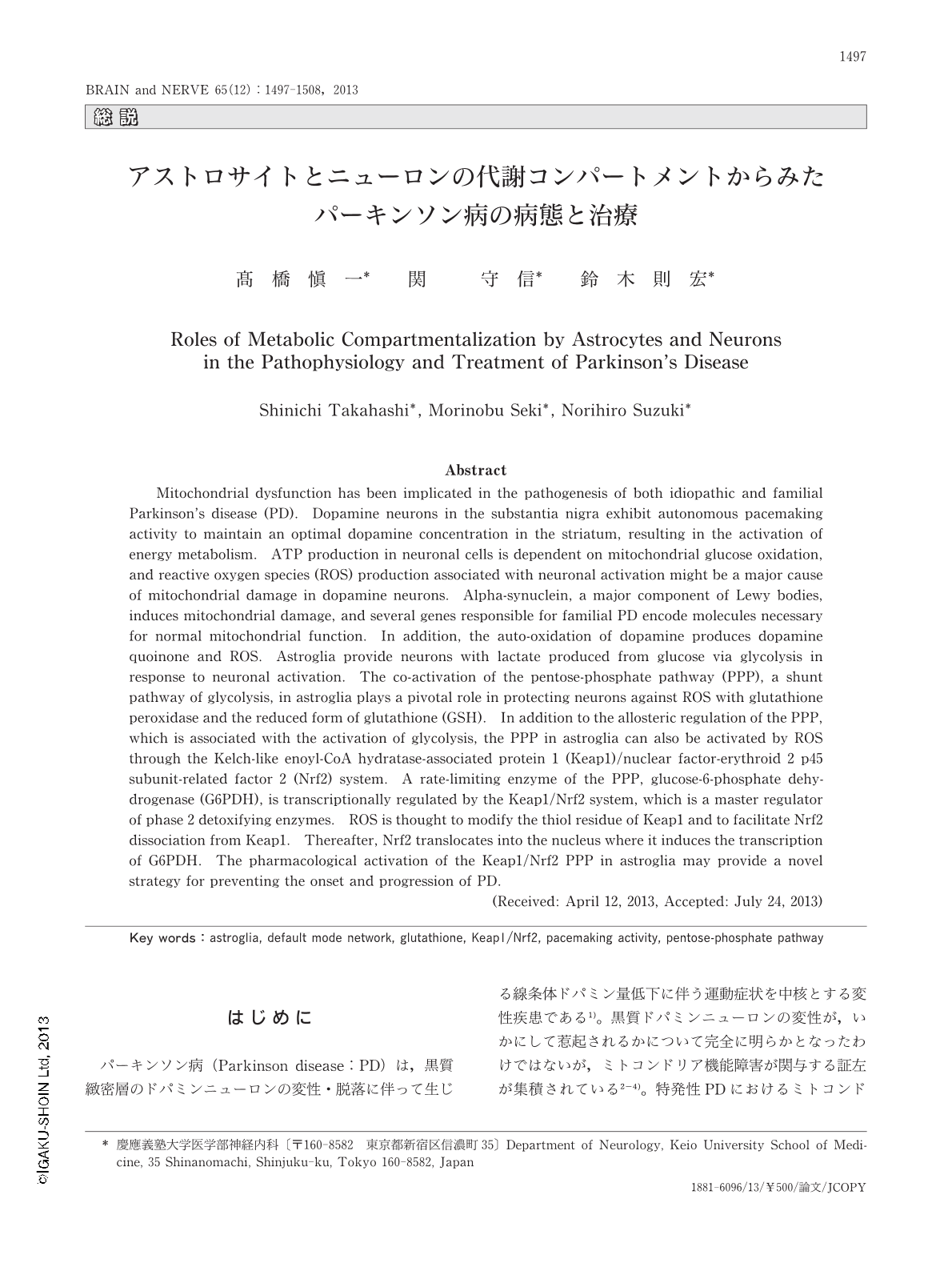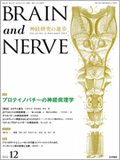Japanese
English
- 有料閲覧
- Abstract 文献概要
- 1ページ目 Look Inside
- 参考文献 Reference
はじめに
パーキンソン病(Parkinson disease:PD)は,黒質緻密層のドパミンニューロンの変性・脱落に伴って生じる線条体ドパミン量低下に伴う運動症状を中核とする変性疾患である1)。黒質ドパミンニューロンの変性が,いかにして惹起されるかについて完全に明らかとなったわけではないが,ミトコンドリア機能障害が関与する証左が集積されている2-4)。特発性PDにおけるミトコンドリア機能異常は,1989年,Schapiraら5)によって,PD患者の剖検脳において呼吸鎖複合体Ⅰの機能低下として生化学的手法から明らかにされ,同年,わが国のMizunoら6)も呼吸鎖複合体Ⅰの免疫ブロッティング低下から同様の結論を導いている。実験的PDモデルに用いられるMPTP(1-methyl-4-phenyl-1,2,3,6-tetrahydro-pyridine)は,代謝後にMPP+として選択的な複合体Ⅰ阻害作用を呈し,MPTP全身投与は黒質ドパミンニューロンの選択的障害とともにパーキンソン症状を惹起する7)。
特発性PDの病理学的な疾患ホールマークと考えられるレヴィ小体,その構成成分であるαシヌクレインとミトコンドリア機能異常の密接な関連についても知見が集積しつつある8-11)。また,家族性PDにおいてもミトコンドリア機能異常が示唆されており12-13),現在までに同定された変異遺伝子(座)(Table:PARK1~18)およびその産物の機能解析から,少なくともparkin(PARK2)14),PINK1(PARK6)15),DJ-1(PARK7)16),LRRK2(PARK8)17),Omi/HtrA2(PARK13)18)でミトコンドリア機能異常との関連が示されている。
ミトコンドリア機能障害と活性酸素種(reactive oxygen species:ROS)は正常者の老化とも密接に関連し19,20),加齢を最大のリスクファクターとする特発性PD21,22)のみならず,若年者にも発症しうる家族性PDの双方においてミトコンドリア機能異常が重要な役割を果たすと推論することは理に適っている。ミトコンドリアはATP産生の場であり,脳はもともと高いエネルギー代謝を持つ臓器であるため,グルコースを基質としたエネルギー代謝に伴うROSによる酸化ストレスを受けやすい23-25)。脳は,酸化ストレスへの生得的な内因性保護機構を有すると考えられるが,特発性PD,家族性PDともにその破綻の結果とも解釈できる。
本稿では,ニューロンにおけるグルコース代謝のサポートと酸化ストレスへの保護機構の中核をなすアストロサイトの生理機能に注目し,PDのミトコンドリア機能障害仮説と治療戦略を,ニューロンとアストロサイトからなる代謝コンパートメントからまとめる。
Abstract
Mitochondrial dysfunction has been implicated in the pathogenesis of both idiopathic and familial Parkinson's disease (PD). Dopamine neurons in the substantia nigra exhibit autonomous pacemaking activity to maintain an optimal dopamine concentration in the striatum, resulting in the activation of energy metabolism. ATP production in neuronal cells is dependent on mitochondrial glucose oxidation, and reactive oxygen species (ROS) production associated with neuronal activation might be a major cause of mitochondrial damage in dopamine neurons. Alpha-synuclein, a major component of Lewy bodies, induces mitochondrial damage, and several genes responsible for familial PD encode molecules necessary for normal mitochondrial function. In addition, the auto-oxidation of dopamine produces dopamine quoinone and ROS. Astroglia provide neurons with lactate produced from glucose via glycolysis in response to neuronal activation. The co-activation of the pentose-phosphate pathway (PPP), a shunt pathway of glycolysis, in astroglia plays a pivotal role in protecting neurons against ROS with glutathione peroxidase and the reduced form of glutathione (GSH). In addition to the allosteric regulation of the PPP, which is associated with the activation of glycolysis, the PPP in astroglia can also be activated by ROS through the Kelch-like enoyl-CoA hydratase-associated protein 1 (Keap1)/nuclear factor-erythroid 2 p45 subunit-related factor 2 (Nrf2) system. A rate-limiting enzyme of the PPP, glucose-6-phosphate dehydrogenase (G6PDH), is transcriptionally regulated by the Keap1/Nrf2 system, which is a master regulator of phase 2 detoxifying enzymes. ROS is thought to modify the thiol residue of Keap1 and to facilitate Nrf2 dissociation from Keap1. Thereafter, Nrf2 translocates into the nucleus where it induces the transcription of G6PDH. The pharmacological activation of the Keap1/Nrf2 PPP in astroglia may provide a novel strategy for preventing the onset and progression of PD. (Received: April 12, 2013, Accepted: July 24, 2013)

Copyright © 2013, Igaku-Shoin Ltd. All rights reserved.


